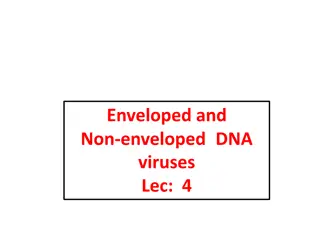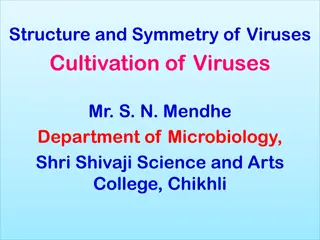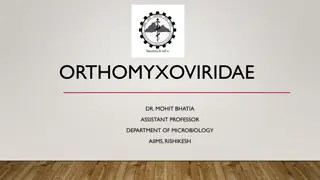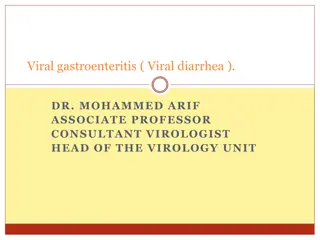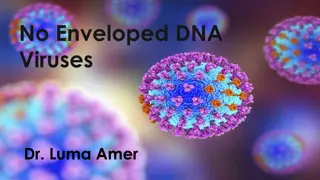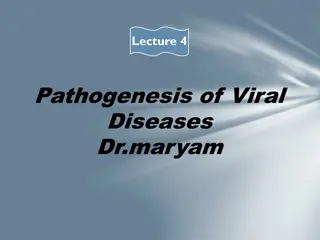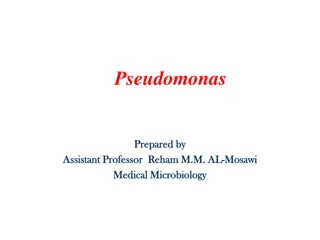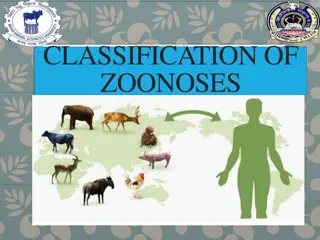Understanding Viruses: Basics and Morphology
Viruses are the smallest unicellular organisms that are obligate intracellular. They lack cellular organization like bacteria, and their multiplication is complex. Viruses have either DNA or RNA and are classified based on their nucleic acid. Their structure includes nucleic acid and a capsid composed of protein subunits. Capsid symmetry can be icosahedral or helical, based on the arrangement of capsomeres.
Download Presentation

Please find below an Image/Link to download the presentation.
The content on the website is provided AS IS for your information and personal use only. It may not be sold, licensed, or shared on other websites without obtaining consent from the author. Download presentation by click this link. If you encounter any issues during the download, it is possible that the publisher has removed the file from their server.
E N D
Presentation Transcript
Viruses Smallest unicellular organisms that are obligate intracellular. Viruses are the most primitive microorganisms infecting man.
General properties Obligate intracellular Possess either DNA (deoxyribonucleic acid) or RNA (ribonucleic acid), but never both Smaller than bacteria, can be passed through the bacterial filters Cannot be grown on artificial cell free media (grow in animals, embryonated eggs or tissue culture)
Viruses differ from bacteria :- Multiply by a complex method (not by binary fission). Do not have a proper cellular organisation. Do not have cell wall or cell membrane or cellular organelles including ribosomes Lack the enzymes necessary for protein and nucleic acid synthesis. Not susceptible to antibacterial antibiotics
MORPHOLOGY OF VIRUS Nucleic acid Nucleic acid may be single or double stranded, circular or linear, segmented or un-segmented. Viruses are classified based on nucleic acid as DNA viruses and RNA viruses.
Capsid Composed of a number of repeated protein subunits (polypeptides) called capsomeres. Functions: oProtects the nucleic acid core from the external environment oIn non-enveloped viruses - initiates the first step of viral replication. oAntigenic and specific for each virus.
Symmetry Based on arrangement of capsomeres Type of symmetry Explanation Examples Icosahedral (cubical) symmetry Capsomeres are arranged as if they lay on the faces of an icosahedron 20 triangular facets and 12 corners or vertices Rigid structure. All DNA viruses (except poxviruses) Most of the RNA viruses have icosahedral symmetry
Symmetry Based on arrangement of capsomeres Type of symmetry Explanation Examples Helical symmetry Capsomeres are coiled surrounding the nucleic acid in the form of a helix or spiral. Flexible structure. RNA viruses such as- myxoviruses, rhabdoviruses, filoviruses, bunyaviruses, etc.
Symmetry Based on arrangement of capsomeres Type of symmetry Explanation Examples Complex symmetry Do not have either of the above symmetry. Poxviruses
Envelope Envelope surrounding the nucleocapsid. Lipoprotein in nature. oLipid part is derived from host cell membrane oProtein part is virus coded, made up of subunits called peplomers. o Peplomers - project as spikes on the surface of the envelope.
Envelope More susceptible to heat and lipid solvents like ether Antigenic - facilitates entry of the virus More than one kind of peplomers can be seen in some viruses, e.g. Influenza viruses possess haemagglutinin and neuraminidase peplomers.
Envelope Most viruses are enveloped except: oNon-enveloped DNA viruses- parvovirus, adenovirus and papovavirus oNon-enveloped RNA viruses-picornavirus, hepatitis A virus &hepatitis E virus.
Size of the viruses Size vary from 20-300nm in size. Smallest virus - parvovirus(20 nm) Largest - poxvirus (300nm). Because of the small size, viruses can pass through bacterial filters and they cannot be visualized under light microscope.
Size of the viruses Determined by Electron microscope (best method) Ultracentrifugation- Viral particles suspended in liquid medium when subjected to ultracentrifugation, will settle down at a sedimentation rate that is proportional to their size. Passage through membrane filters of different pore sizes- The maximum pore size that prevents a virus to pass through multiplied by 0.64 yields the approximate diameter of the viral particle.
CLASSIFICATION Family DNA type Envelop Symmetry Representative Viruses Size (nm) 150-200 e Yes Herpesviridae Icosahedron ds, linear Herpes simplex virus - 1 Herpes simplex virus- 2 Varicella-zoster virus Epstein-Barr virus Cytomegalovirus Human herpes virus 6,7 & 8 Hepatitis B virus Hepadnaviridae ds, circular, Yes Icosahedron 40 48 incomplete ss, linear ds, circular Absent Parvoviridae Papovaviridae Absent Icosahedron Icosahedron 18 26 45-55 Parvovirus B19 Human papillomaviruses JC virus and BK virus 230 x 400 1. Variola (smallpox) 2. Molluscum contagiosum virus 70 90 1. Human adenoviruses Poxviridae ds, linear Yes Complex Adenoviridae ds, linear Absent Icosahedron
CLASSIFICATION RNA Viruses Picornaviridae RNA type ss, +ve sense Absent Envelope Symmetry Size(nm) 28 30 Representative Viruses Poliovirus Coxsackievirus Echovirus Enterovirus Rhinovirus Hepatitis A virus Icosahedral Caliciviridae ss, +ve sense Absent Icosahedral 27-40 Norwalk agent Hepatitis E virus Togaviridae ss, +ve sense Yes Icosahedral 50-70 Rubella virus Eastern equine encephalitis virus Western equine encephalitis virus
CLASSIFICATION RNA Viruses Flaviviridae RNA type ss, +ve sense Yes Envelope Symmetry Size(nm) 40-60 Representative Viruses Yellow fever virus Dengue virus St. Louis encephalitis virus West Nile virus Hepatitis C virus Icosahedral (?) Coronaviridae Rhabdoviridae ss, +ve sense Yes ss, -ve sense Helical Helical 120-160 75x180 Coronaviruses Rabies virus Vesicular stomatitis virus Yes Filoviridae ss, -ve sense Yes Helical 80 x 1000 Marburg virus Ebola virus
CLASSIFICATION RNA Viruses RNA type Symmetry Size(nm) Representative Viruses Envelop e Yes Helical 150 300 Parainfluenza virus Mumps virus Measles virus Respiratory syncytial virus Newcastle disease virus Metapneumovirus Paramyxoviridae ss, -ve sense Yes Helical 80 120 Influenza viruses- A, B, and C Orthomyxoviridae ss, -ve sense, 8 segments ss, -ve sense, 3 circular segments Yes Helical 80 120 Bunyaviridae Hantavirus California encephalitis virus Sandfly fever virus
CLASSIFICATION RNA Viruses RNA type Bunyaviridae ss, -ve sense, 3 circular segments Envelope Symmetry Yes Size(nm) Representative Viruses 80 120 Hantavirus California encephalitis virus Sandfly fever virus Helical Arenaviridae Yes Helical (?) 50-300 ss, -ve sense, RNA,2 circular segments Lymphocytic choriomeningitis virus Lassa fever virus South American hemorrhagic fever virus Reoviridae Absent Icosahedral 60-80 ds, 10 12 segments Rotavirus Reovirus Colorado tick fever virus Retroviridae Yes 80-110 2 identical copies of +ve sense ss RNA Icosahedral (spherical) HTLV (Human T Lymphotropic virus) HIV (Human immunodeficiency virus)
Adsorption/attachment First and most specific step. Involves receptor interactions. Viruses have attachment sites on their envelopes or capsid proteins that bind to the complementary receptor sites present on the host cell surface. HIV: Viral surface glycoprotein gp120binds toCD4molecules on the host cells. o Influenza: Viral hemagglutinin (an envelope protein) binds specifically to glycoprotein receptors present on the surface of respiratory epithelium. o
Viral Replication Viruses undergo a complex way of cell division. Replication of viruses passes through six sequential steps: 1) Adsorption/attachment 2) Penetration 3) Uncoating 4) Biosynthesis 5) Assembly 6) Maturation 7) Release
Penetration Mechanism Explanation Phagocytosis (viropexis) Receptor mediated endocytosis Membrane fusion Some enveloped viruses (e.g. HIV) enter by fusion of their envelope proteins with the plasma membrane of the host cell so that only the nucleocapsid enters into the cytoplasm, whereas the viral envelope remains attached to the host cell membrane. Injection of nucleic acid Bacteriophages cannot penetrate the rigid bacterial cell wall, hence only the nucleic acid is injected while the capsid remains attached to the cell wall.
Uncoating By the action of lysosomal enzymes of the host cells, the viral capsid gets separated and the nucleic acid is released into the cytoplasm. Absent for bacteriophages.
Biosynthesis Following viral components are synthesized: oNucleic acid oCapsid protein oEnzymes required for various stages of viral replication oRegulatory proteins to shut down the host cell metabolism.
Site of Nucleic acid replication DNA viruses: DNA replication occurs in the nucleus except in poxviruses, which synthesize DNA in the cytoplasm. RNA viruses - RNA replication occurs in cytoplasm except in retroviruses and orthomyxoviruses, which synthesize RNA in the nucleus.
Assembly Viral nucleic acid and proteins are packaged together to form progeny viruses (nucleocapsids). Occurs in the host cell nucleus or cytoplasm. oDNA viruses are assembled in the nucleus except hepadnaviruses and poxviruses (in cytoplasm) oRNA viruses are assembled in the cytoplasm.
Maturation Following assembly, maturation of daughter virions take place either in the nucleus or cytoplasm or membranes (golgi or endoplasmic reticulum or plasma membrane)
Release Lysis of the host cells (non enveloped viruses and bacteriophages). Budding through host cell membrane (enveloped viruses) - During budding, they acquire a part of the host cell membrane to form the lipid part of their envelopes. Envelope is acquired either from plasma membrane (influenza virus) or from nuclear membrane (e.g. herpesviruses). Viral glycoproteins are then inserted into the envelopes. Excess viral glycoproteins are synthesized to saturate cell receptors so thatthe viruses will not stick to the host cell following release.
Eclipse phase Defined as interval between the penetration of the virus into the host cell till the appearance of first infectious virus progeny particle . During this period, the virus cannot be demonstrated inside the host cell. Duration -15 to 30 minutes for bacteriophages and 15-30 hours for most of the animal viruses.
References Textbook of Medical Microbiology by Ananthnarayan, Paniker Textbook of Medical Microbiology by C.P Baweja Textbook of Medical Microbiology by S. Bhat, A.S.Sastry Textbook of Medical Microbiology by D.R.Arora, Brij bala Arora






